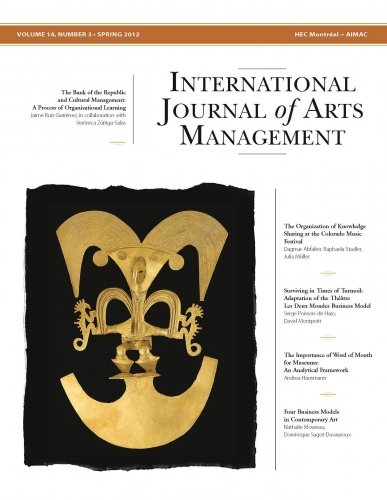Surviving in Times of Turmoil: Adaptation of the Théâtre Les Deux Mondes Business Model
Produit: Article
21,00 $ CA
Serge Poisson-de Haro, David Montpetit
Serge Poisson-de Haro, PhD (IESE Business School, Spain), is Assistant Professor in the management department at HEC Montréal. His teaching and research interests are in the field of strategy. He is particularly interested in understanding the strategic management issues of artistic organizations. He has served on the boards of not-forprofit organizations such as the Canadian Opera Company and DareArts For Children. He publishes regularly in the International Journal of Arts Management and was a speaker at the 2009 AIMAC conference in Dallas, Texas.
David Montpetit held the position of CFO at Théâtre Les Deux Mondes from 2001 to 2007. He recently completed his MSc at HEC Montréal. His dissertation, written under the supervision of Dr. Poisson-de Haro, focused on the implementation of the United Nations Global Compact initiative in various organizations.
ABSTRACT
The research objective was to understand how an arts organization might adjust its business model to meet challenges resulting from a context of turmoil. The focus of the analysis is a single case, Théâtre Les Deux Mondes (TDM), a leading Canadian theatrical touring company. The authors propose assessing the adaptation of a performing arts organization’s business model. They show that TDM has adapted its business model to respond to both external and internal turmoil, whether sudden or gradual. The model takes into account the resource profile of the organization, its stakeholders – such as government funding agencies and donors – and the profitability of its portfolio. The authors suggest that some resources and capabilities are more important than others in adapting the business model components (customer value proposition, key resources, key processes and non-profit formula) in response to external and internal turmoil.
KEYWORDS
Business model, resources, dynamic capabilities, artistic organization, turmoil
RÉSUMÉ
Notre objectif de recherche est de comprendre comment une organisation artistique peut ajuster son modèle d’affaires pour faire face aux défis résultant d’un environnement agité. Notre analyse se centre sur le Théâtre Les deux mondes (TDM), une compagnie de théâtre de tournée reconnue internationalement. Nous faisons une évaluation du modèle d’affaires de cette compagnie des arts de la scène. Nous montrons que TDM a adapté son modèle d’affaires pour répondre à une situation d’agitation externe et interne, soudaine ou graduelle. Le modèle prend en compte le profil de ressources de l’organisation, ses parties prenantes telles que les agences gouvernementales et les donateurs, et la profitabilité du portefeuille de production. Nous suggérons que certaines ressources et capacités sont plus importantes que d’autres dans l’adaptation des composantes du modèle d’affaires (proposition de valeur client, ressources-clés, processus-clés et formule à but non lucratif) pour répondre aux situations d’agitation interne ou externe.
MOTS CLÉS
Modèle d’affaires, ressources, capacités dynamiques, organisation artistique, agitation
RESUMEN
Nuestra investigación tiene como propósito el entender la manera en la que una organización del sector de las artes puede adecuar su modelo empresarial para solventar los retos que un entorno turbulento acarrea. Con tales fines, centramos nuestro análisis sobre el Théâtre Les deux mondes (TDM), une compañía teatral ambulante reconocida internacionalmente. A raíz de una evaluación de su modelo empresarial mostramos cómo una compañía de artes escénicas como esta ha sabido adecuar su modelo empresarial para responder a una situación de turbulencia externa e interna, repentina y gradual. Dicho modelo tiene en cuenta el perfil de los recursos de la organización, sus partes interesadas tales como agencias de gobierno y donantes, así como la rentabilidad de la cartera de producción. Sugerimos que con fines de adecuar los componentes del modelo empresarial a situaciones de turbulencia interna o externa, ciertos recursos y capacidades adquieren mayor importancia (propuesta de valor al cliente, recursos claves, procesos claves y fórmula sin ánimo de lucro).
PALABRAS CLAVE
Modelo empresarial, recursos, capacidades dinámicas, organización artística, turbulencia

